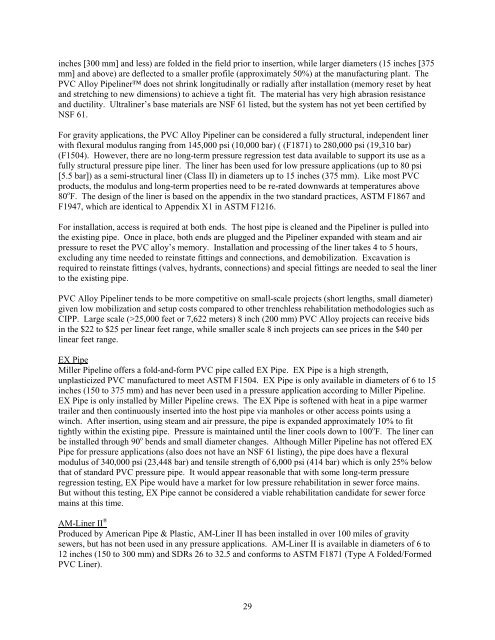State of Technology Report for Force Main Rehabilitation, Final ...
State of Technology Report for Force Main Rehabilitation, Final ...
State of Technology Report for Force Main Rehabilitation, Final ...
You also want an ePaper? Increase the reach of your titles
YUMPU automatically turns print PDFs into web optimized ePapers that Google loves.
inches [300 mm] and less) are folded in the field prior to insertion, while larger diameters (15 inches [375<br />
mm] and above) are deflected to a smaller pr<strong>of</strong>ile (approximately 50%) at the manufacturing plant. The<br />
PVC Alloy Pipeliner does not shrink longitudinally or radially after installation (memory reset by heat<br />
and stretching to new dimensions) to achieve a tight fit. The material has very high abrasion resistance<br />
and ductility. Ultraliner’s base materials are NSF 61 listed, but the system has not yet been certified by<br />
NSF 61.<br />
For gravity applications, the PVC Alloy Pipeliner can be considered a fully structural, independent liner<br />
with flexural modulus ranging from 145,000 psi (10,000 bar) ( (F1871) to 280,000 psi (19,310 bar)<br />
(F1504). However, there are no long-term pressure regression test data available to support its use as a<br />
fully structural pressure pipe liner. The liner has been used <strong>for</strong> low pressure applications (up to 80 psi<br />
[5.5 bar]) as a semi-structural liner (Class II) in diameters up to 15 inches (375 mm). Like most PVC<br />
products, the modulus and long-term properties need to be re-rated downwards at temperatures above<br />
80 o F. The design <strong>of</strong> the liner is based on the appendix in the two standard practices, ASTM F1867 and<br />
F1947, which are identical to Appendix X1 in ASTM F1216.<br />
For installation, access is required at both ends. The host pipe is cleaned and the Pipeliner is pulled into<br />
the existing pipe. Once in place, both ends are plugged and the Pipeliner expanded with steam and air<br />
pressure to reset the PVC alloy’s memory. Installation and processing <strong>of</strong> the liner takes 4 to 5 hours,<br />
excluding any time needed to reinstate fittings and connections, and demobilization. Excavation is<br />
required to reinstate fittings (valves, hydrants, connections) and special fittings are needed to seal the liner<br />
to the existing pipe.<br />
PVC Alloy Pipeliner tends to be more competitive on small-scale projects (short lengths, small diameter)<br />
given low mobilization and setup costs compared to other trenchless rehabilitation methodologies such as<br />
CIPP. Large scale (>25,000 feet or 7,622 meters) 8 inch (200 mm) PVC Alloy projects can receive bids<br />
in the $22 to $25 per linear feet range, while smaller scale 8 inch projects can see prices in the $40 per<br />
linear feet range.<br />
EX Pipe<br />
Miller Pipeline <strong>of</strong>fers a fold-and-<strong>for</strong>m PVC pipe called EX Pipe. EX Pipe is a high strength,<br />
unplasticized PVC manufactured to meet ASTM F1504. EX Pipe is only available in diameters <strong>of</strong> 6 to 15<br />
inches (150 to 375 mm) and has never been used in a pressure application according to Miller Pipeline.<br />
EX Pipe is only installed by Miller Pipeline crews. The EX Pipe is s<strong>of</strong>tened with heat in a pipe warmer<br />
trailer and then continuously inserted into the host pipe via manholes or other access points using a<br />
winch. After insertion, using steam and air pressure, the pipe is expanded approximately 10% to fit<br />
tightly within the existing pipe. Pressure is maintained until the liner cools down to 100 o F. The liner can<br />
be installed through 90 o bends and small diameter changes. Although Miller Pipeline has not <strong>of</strong>fered EX<br />
Pipe <strong>for</strong> pressure applications (also does not have an NSF 61 listing), the pipe does have a flexural<br />
modulus <strong>of</strong> 340,000 psi (23,448 bar) and tensile strength <strong>of</strong> 6,000 psi (414 bar) which is only 25% below<br />
that <strong>of</strong> standard PVC pressure pipe. It would appear reasonable that with some long-term pressure<br />
regression testing, EX Pipe would have a market <strong>for</strong> low pressure rehabilitation in sewer <strong>for</strong>ce mains.<br />
But without this testing, EX Pipe cannot be considered a viable rehabilitation candidate <strong>for</strong> sewer <strong>for</strong>ce<br />
mains at this time.<br />
AM-Liner II ®<br />
Produced by American Pipe & Plastic, AM-Liner II has been installed in over 100 miles <strong>of</strong> gravity<br />
sewers, but has not been used in any pressure applications. AM-Liner II is available in diameters <strong>of</strong> 6 to<br />
12 inches (150 to 300 mm) and SDRs 26 to 32.5 and con<strong>for</strong>ms to ASTM F1871 (Type A Folded/Formed<br />
PVC Liner).<br />
29















